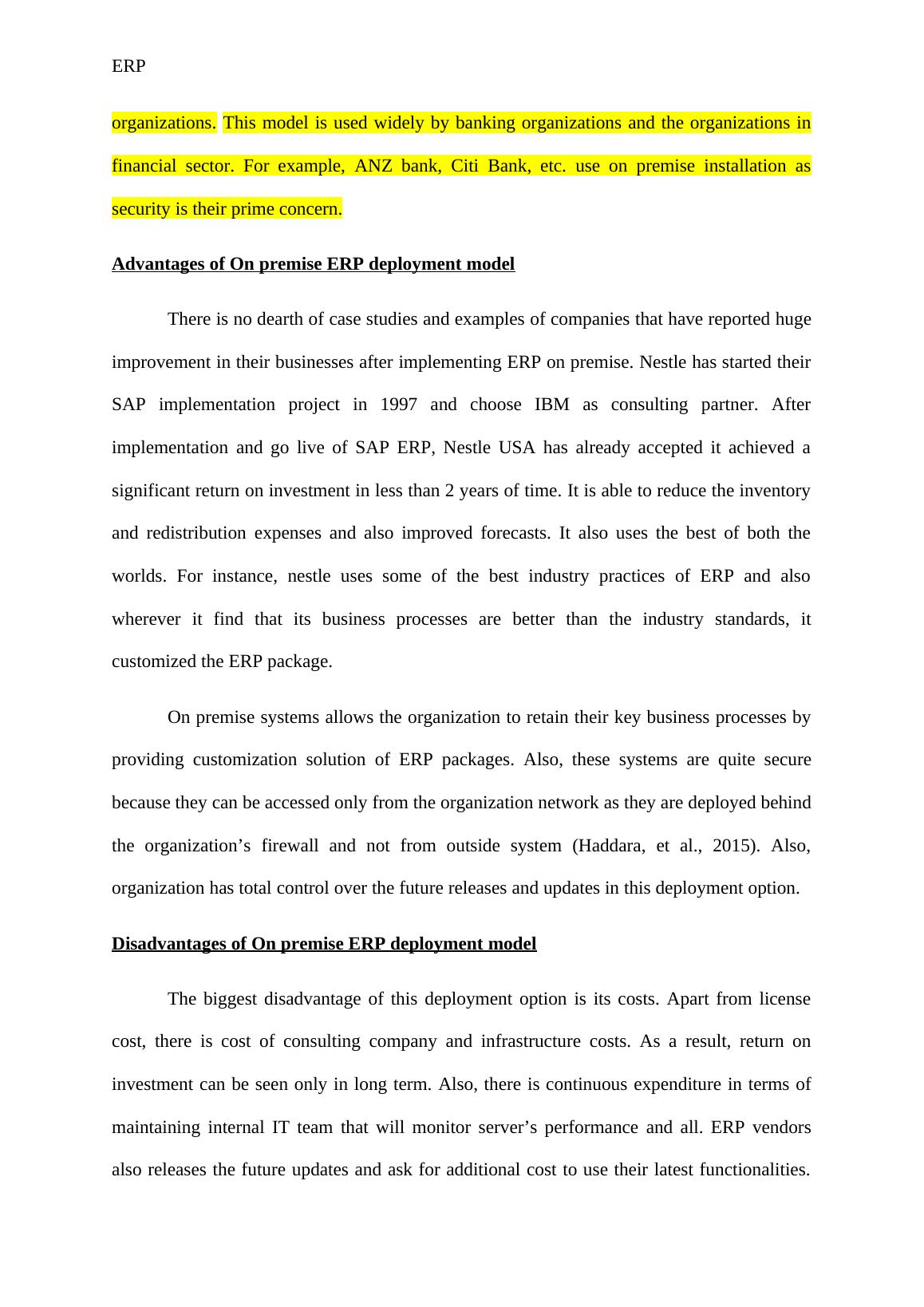ERP Name of STUDENT Course Name Name Introduction ERP Systems and Software Accounting Packages
Added on 2021-06-18
13 Pages3701 Words374 Views
ERP NAME OF STUDENTCOURSE NAME

ERP IntroductionERP systems and software accounting packages whose main purpose is to automatethe business process in organization and making them more focused on their core activitiesand leave the supporting functions to ERP has gained a lot of popularity in this age ofdigitalization. It is because digitalization has opened the new doors and also promotedglobalization. Today, organizations can have access to the suppliers worldwide and also theircustomer base has also expanded from domestic to worldwide. As a result, organizationshave much larger operational work, non -value added activities, redundant data entry,multiple entry of data, silos of department. As a result of this, ERPs have become the need ofmost of the business organisations today that have globalized operations. During the 1990s,ERPs systems were implemented by only the larger organizations as these systems were quitecomplex and often requires change management and has inherent risk. Due to their massivecost structure, the return on investment (ROI) also take long duration. However, thesedynamics have completely changed today. Due to the popularization of smart phones,Internet and technology, e-commerce and e-business have become quite common today andmany organizations conduct significant part of their business using internet. Though cloudcomputing has become a buzz word today, it has its roots in 1950s. The idea of sellingcomputers like electricity by leveraging sharing of resources has already been developed bycompute visionaries like John McCarthy and the APRANT project has also been started fortoday. However, Amazon web services take this to another level today. There are largenumber of software, ERPs that leverages amazon web services in creating their cloud basedproduct. Also, Cloud based ERPs come with a far less hassle as compared to traditional onpremise model and also quite cheaper and return on investment is also very good. Though,Cloud computing has quite higher acceptance among small and medium scale enterprises,Large enterprise are still hesitant to opt for cloud computing because they have already

ERP established huge sum of money to implement the on premise systems and also over-customized their ERP systems. There is also a middle path between the on premise ERP andcloud computing ERP models which is called as hosted or hybrid ERP. In this model, whilecompanies purchases the licenses of the ERP themselves, they do not buy the storage andserver themselves and instead use the services of IAAS (Infrastructure as a Service) Vendors.The purpose of this paper is to critically analyse the different models of implementingERP and their pros and cons. It will also take examples of main ERPs like SAP, Oracle,Microsoft, Infor and Epicor that captures majority of the market.Comparison of different ERP Implementation ModelsThere are different models of ERP implementation like on premise or cloud. There is no best or worst system as it depends on the objectives of the organization. The organization that wants to save cost usually follow cloud based system and the organizations that want high security of data would follow on premise system. The bottom line is that the choice of ERP system should suit the organization and it should gel with the business objectives of the organization. These different types of implementations can be discussed in detail as:On-Premise ERP implementation ModelOn premise is also known as the traditional method of implementing ERP in whichthe organization buys the software, storage space as well as server and maintain the server attheir end. Thus, organizations also need to create their own internal IT team on a permanentbasis to maintain and monitor the server and database. Also, when organizations buys thesecomplex ERPs, there is often large changes occurs in the organization like business processchange, change management so as to motivate the end users to use the new product, testing ofthe various configurations and thus also requires an implementation consultant. There areorganizations like Deloitte and Accenture that provides the implementation guidance to the

ERP organizations.This model is used widely by banking organizations and the organizations infinancial sector. For example, ANZ bank, Citi Bank, etc. use on premise installation assecurity is their prime concern.Advantages of On premise ERP deployment modelThere is no dearth of case studies and examples of companies that have reported hugeimprovement in their businesses after implementing ERP on premise. Nestle has started theirSAP implementation project in 1997 and choose IBM as consulting partner. Afterimplementation and go live of SAP ERP, Nestle USA has already accepted it achieved asignificant return on investment in less than 2 years of time. It is able to reduce the inventoryand redistribution expenses and also improved forecasts. It also uses the best of both theworlds. For instance, nestle uses some of the best industry practices of ERP and alsowherever it find that its business processes are better than the industry standards, itcustomized the ERP package. On premise systems allows the organization to retain their key business processes byproviding customization solution of ERP packages. Also, these systems are quite securebecause they can be accessed only from the organization network as they are deployed behindthe organization’s firewall and not from outside system (Haddara, et al., 2015). Also,organization has total control over the future releases and updates in this deployment option. Disadvantages of On premise ERP deployment modelThe biggest disadvantage of this deployment option is its costs. Apart from licensecost, there is cost of consulting company and infrastructure costs. As a result, return oninvestment can be seen only in long term. Also, there is continuous expenditure in terms ofmaintaining internal IT team that will monitor server’s performance and all. ERP vendorsalso releases the future updates and ask for additional cost to use their latest functionalities.

End of preview
Want to access all the pages? Upload your documents or become a member.
Related Documents
Paper - Data Security Issues In Cloud Computinglg...
|4
|1694
|129
Cloud based ERP Systems in the Cloud Name of the Student Name of the Universitylg...
|18
|5055
|267
ERP Systems in the Cloud System Assignmentlg...
|13
|3976
|357
Management Assignment On ERP Systemslg...
|14
|3789
|280
(PDF) Integrated Business Processes with ERP Systemslg...
|12
|3209
|308
Foxmeyer Drug ERP Case Studylg...
|13
|3400
|158
